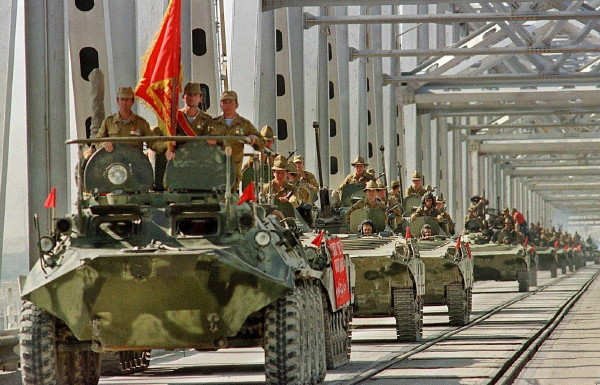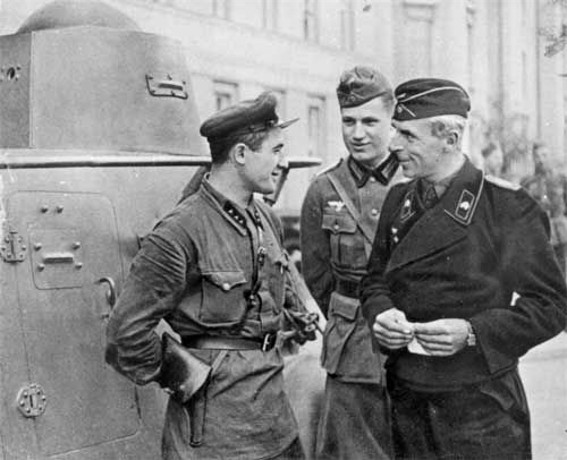Soviet Army
Soviet Army [Russian: Советская Армия; Sovetskaia Armiia; Ukrainian: Радянська Армія; Radianska Armiia]. The regular army of the USSR, known until September 1946 as the Workers’ and Peasants’ Red Army or simply the Red Army. It was established by decree of the Soviet government on 28 January 1918 out of Red Guard Detachments. The Bolshevik troops that brought Ukraine under Soviet control in 1918–20 were generally Russian in national composition. They received support from Ukrainian or partly Ukrainian units, such as the Red Cossacks, the Tarashcha Division, and the Bohun Regiment, and occasional help from partisan groups (see Partisan movement in Ukraine, 1918–22) led by Nestor Makhno, Nykyfor Hryhoriv, and Danylo Zeleny. For a while (January–April 1920) Galicians formed their own unit, the Red Ukrainian Galician Army, within the Red Army. The Communist commander of the Ukrainian front, Volodymyr Antonov-Ovsiienko, was responsible to Moscow, not to the Bolshevik government of Ukraine in Kharkiv. The People's Commissariat for Military Affairs in Kharkiv had no real power and was abolished in 1919.
The Ukrainian SSR never had its own army. In the 1920s, territorial divisions consisting of Ukrainians and using the Ukrainian language as the language of command constituted a militia and were stationed in the larger cities. Except for the Red Cossacks, stationed near Proskuriv, Starokostiantyniv, and Berdychiv, regular army units in Ukraine were of mixed national composition, and used Russian. Most Ukrainians in the regular forces were stationed outside Ukraine. The commander of the Ukrainian-Crimean Military District was responsible not to the government of the Ukrainian SSR, but to Moscow. With the abolition of the territorial units (1934) and the division of Ukraine into three military districts (1938), Ukraine was integrated even more closely into the all-Union military system. By 1937 Russian became the language of command in all military units. Also, the military traditions of the imperial Russian army (eg, officer ranks, uniforms, People's Commissariat insignia) were gradually reintroduced.
During the Second World War, 4.5 million Ukrainians served in the Red Army. Except for the First Ukrainian Partisan Division (est 1943) under Col Petr Vershigora, there were no separate Ukrainian units in the Soviet armed forces. Because of national discrimination, non-Russians refused at first to fight the German invaders: of 3.6 million Soviet prisoners of war by March 1943, 2 million were non-Russian. The harsh treatment of the population and POWs by the Germans eventually persuaded non-Russians to fight. Approximately 1.7 million Ukrainians were decorated for bravery in the war. In 1943 the Bohdan Khmelnytsky Medal was introduced, and in 1944 a People's Commissariat of Defense was established for Ukraine (with Gen Sydir Kovpak as the first commissar), but this was only a symbolic gesture.
After the war the Soviet Army remained an integrated multinational force. The territory of Ukraine was reorganized into three military districts (Kyiv, Odesa, and Subcarpathia), and Donetsk oblast and Luhansk oblast were assigned to the Northern Caucasia Military District. Because of its geographic location along the western border of the USSR and on the Black Sea, Ukraine was strategically important. It was the home of the Black Sea Fleet, major air-fields near Zhytomyr, and missile bases in the Carpathian Mountains.
The Soviet Army was an instrument of Russification. Its medium of communication was exclusively Russian; all of its recreational, cultural, and press activities were in Russian as well. Conscripts spent their term of military service outside their own republics, and demobilized servicemen were encouraged to live and work in new settlements, mostly in the east. Political education in the army promoted Russian chauvinism and glorified Russian military heroes. Besides national discrimination, the army suffered from a rigid caste system similar to that of the tsarist army. The officers were separated sharply from the common soldiers by material privileges, uniforms, honors, and statutes.
In its Declaration on State Sovereignty (16 July 1990) the Supreme Soviet of the Ukrainian SSR stated its intention to nationalize the army in Ukraine. As the first step toward implementing this proclamation it demanded that all Ukrainians serving in the Soviet armed forces be stationed in Ukraine by 1 December 1990.
BIBLIOGRAPHY
Zakharov, V. (ed). 50 let vooruzhennykh sil SSSR (Moscow 1968)
Avidar, Y. The Party and the Army in the Soviet Union (Jerusalem 1983)
Seaton, A; Seaton, J. The Soviet Army, 1918 to the Present (London 1986)
Hagen, von M. Soldiers in the Proletarian Dictatorship (Ithaca, NY 1990)
Lev Shankovsky
[This article originally appeared in the Encyclopedia of Ukraine, vol. 4 (1993).]



.jpg)